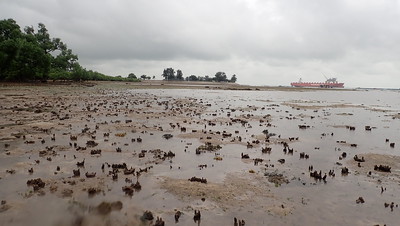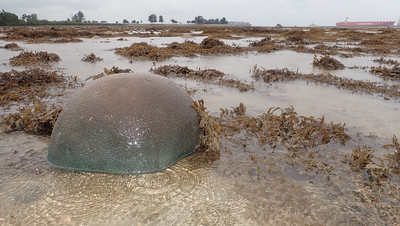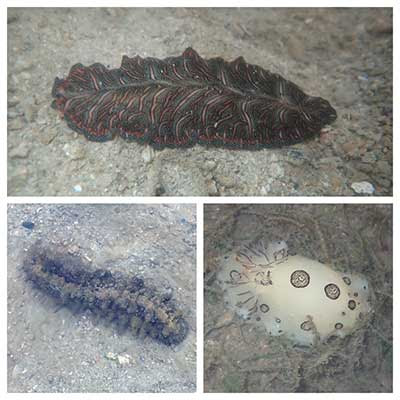Despite the soapy rain, the shores were very much alive with lush seagrasses, small corals and lots of marine life.
There are not a lot of corals on this shore. And I couldn't get to the reef edge as it was covered still covered in Sargassum.
The corals I did see seemed mostly alright and I didn't see signs of mass coral bleaching. Most of the coral colonies were small and there were the usual common kinds. Mostly the boulder shaped ones but also some branching corals. I saw quite a few Branching montipora corals, perhaps they are about to form a dense field? There were also a few small colonies of Leathery soft corals
Today, we came across many more Fire anemones than in the past - mostly in the stream draining out of the mangroves. In the stream, there were also Cerianthids. Everywhere on the shore, I saw a lot of Giant carpet anemones and Frilly anemones, as well as Upsidedown jellyfish. None were bleaching.
The narrow sand bar was full of life. I saw several Eggwhite moon snails, Weasel olive snails, Cake sand dollars. James found the Orange sand star! All over the shore, there were also many Common sea stars (some in mating position) and Strawberry cockles.
Other interesting animals I came across included a Durian sea cucumber (which are only common on Semakau) and several Jorunna nudibranchs (very common on all our shores). I also saw a Persian carpet flatworm. The rest of the team saw lots of other interesting marine life too.Kelvin found this banded mantis shrimp, which is not commonly encountered
When the landfill was created, there was a massive effort to replant mangroves behind seawalls. The mangroves there are doing well, and the seawall is full of snails and other marine life. Part of the original mangroves were spared and they are doing well too, with seagrasses growing right up to the mangrove roots.Seagrasses are quite lush near the stream flowing out near the landfill seawall. There are thick growths of the usual common seagrasses. I also saw some patches of Noodle seagrass. The Tape seagrass remain cropped short in many parts, although near the reef edge there are some with longer leaves. Away from the stream though, the area is mostly bare of seagrasses. I looked and couldn't find any clear signs of dugong feeding trails.
Horse mussel clams remain spread out in a large area. In Jan 2020 and Mar 2019, I saw them in small groups of less than 10, spread apart. In Oct 2020, there were a lot more and closer together. Covering an area of about 20m2. The situation is similar today.
More about Pulau Semakau
It is NOT true that the construction of the Landfill created the marine life found on Pulau Semakau. The marine life was there long before the Landfill was built.
Just as Changi Airport and Changi Beach are not the same even though they are near one another and share a name, Pulau Semakau is NOT the same as the Semakau Landfill. The Landfill was created by destroying all of Pulau Saking, and about half of the original Pulau Semakau by building a very long seawall. Fortunately, the landfill was constructed and is managed in such a way that the original mangroves, seagrass meadows and reefs on Pulau Semakau were allowed to remain.
The large barge used by the fish farm seems in good order today. In Jan 2020, there were stinking piles of netting there. Fortunately, we didn't come across any fish nets today on the shore. Although Kelvin found an abandoned fishing rod.
More about Pulau Semakau
It is NOT true that the construction of the Landfill created the marine life found on Pulau Semakau. The marine life was there long before the Landfill was built.
Just as Changi Airport and Changi Beach are not the same even though they are near one another and share a name, Pulau Semakau is NOT the same as the Semakau Landfill. The Landfill was created by destroying all of Pulau Saking, and about half of the original Pulau Semakau by building a very long seawall. Fortunately, the landfill was constructed and is managed in such a way that the original mangroves, seagrass meadows and reefs on Pulau Semakau were allowed to remain.
As the existing half of the Landfill was used up, the Phase 2 of the Landfill was launched. This involved closing the gap of the seawall on the Semakau Landfill, forming one big pool where incinerated ash will be dumped. NEA worked to limit the damage to natural shores during the construction work for this expansion of the landfill.
The 2030 Landuse Plan by the Ministry of National Development released in Jan 2013 shows plans for 'possible future reclamation' (in light blue surrounded by dotted lines) that may impact the eastern shore of Pulau Semakau. More about the possible impact of the 2030 Landuse Plan on our shores.
The Singapore Blue Plan 2018
Pulau Semakau and nearby islands and submerged reefs have been recommended by the Singapore Blue Plan 2018 for Immediate Conservation Priority.
The Blue Plan recommends the intertidal and subtidal marine areas of Pulau Semakau and adjacent Pulau Hantu, and Pulau Jong to be designated Marine Reserve.
The Blue Plan highlights that Pulau Semakau and its associated patch reefs comprise many ecosystems: coral reefs, mangrove areas, intertidal sandflats, seagrass meadows, and coral reefs. The subtidal area of Pulau Jong is larger than the terrestrial area. Pulau Hantu is a popular dive site has seen increasing interest in the past decade due to biodiversity awareness. If protection is accorded to these three islands, zonation plans for use can be implemented to manage tourism and human impacts.
DOWNLOAD the Plan, SUPPORT the Plan! More on the Singapore Blue Plan 2018 site.
Photos by others on this survey
Kelvin Yong
Liz Lim
James Koh
Che Cheng Neo














